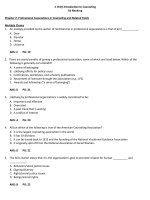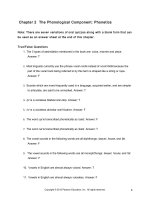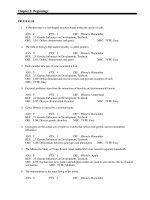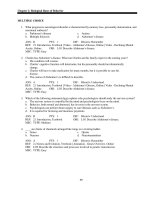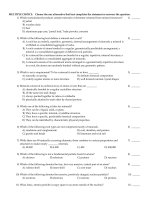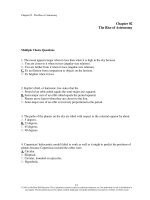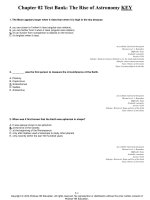Concise introduction to linguistics 3rd edition rowe test bank
Bạn đang xem bản rút gọn của tài liệu. Xem và tải ngay bản đầy đủ của tài liệu tại đây (91.08 KB, 14 trang )
Chapter 2 The Phonological Component: Phonetics
Note: There are seven variations of oral quizzes along with a blank form that can
be used as an answer sheet at the end of this chapter.
True/False Questions
1. The 3 types of assimilation mentioned in the book are: voice, manner and place.
Answer: T
2. Most linguists currently use the phrase vocal cords instead of vocal folds because the
part of the vocal track being referred to by this term is shaped like a string or rope.
Answer: F
3. Sounds which are more frequently used in a language, acquired earlier, and are simpler
to articulate, are said to be unmarked. Answer: T
4. /p/ is a voiceless bilabial oral stop. Answer: T
5. /n/ is a voiceless alveolar oral fricative. Answer: F
6. The word cat is transcribed phonetically as /cæt/. Answer: F
7. The word cat is transcribed phonetically as /kæt/. Answer: T
8. The vowel sounds in the following words are all diphthongs: lawyer, house, and fat.
Answer: F
9. The vowel sounds in the following words are all monophthongs: lawyer, house, and fat.
Answer: F
10. Vowels in English are almost always voiced. Answer: T
11. Vowels in English are almost always voiceless. Answer: F
Copyright © 2012 Pearson Education, Inc. All rights reserved.
8
12. Vowels are sounds that are produced with little or no obstruction of the airstream.
Answer: T
13. Consonants are sounds that are produced with no obstruction of the airstream.
Answer: F
14. The three nasal consonants in English are /m/, /n/ and /ŋ/. Answer: T
15. The three nasal consonants in English are /p/, /g/ and /t/. Answer: F
16. A raised /h/ next to a phonetic symbol, means that the sound is aspirated.
Answer: T
17. A raised /h/ next to a phonetic symbol, means that the sound is unaspirated.
Answer: F
18. There are five vowel sounds in English. Answer: F
19. There are two vowel sounds in the word grade. Answer: F
20. There are twelve main monophthong vowel sounds in most varieties of American
English. Answer: T
21. In speech, fundamental frequency is the rate at which the vocal folds (cords) vibrate.
Answer: T
22. Pitch is never a linguistically significant phonetic feature. Answer: F
23. Mandarin is an intonational language and English is a tonal language.
Answer: F
Copyright © 2012 Pearson Education, Inc. All rights reserved.
9
24. Tone is a specific pitch or a specific change in pitch that functions in tonal languages to
distinguish words which are made up of the same segments.
Answer: T
25. In English, a vowel that comes before a voiced consonant usually has a longer duration
that a vowels that comes before a voiceless consonant. Answer: T
26. In English, differences in the duration of a vowel always change the meaning of words
that are the same in every other way. Answer: F
27. The junctions in the pair /gre+det/ and /gred+et/are called perceived junctures because
they may not be physically produced during speech. Answer: T
28. Differences in the amount of stress that different syllables receive in a multisyllabic
word might change the meaning of the word. Answer: T
29. In English, differences in stress can change the meaning of a monosyllabic word.
Answer: F
30. Generally speaking, people can tell where one word ends and another word starts
(word boundaries) even when listening to a language they do not know at all. Answer: F
31. Linguists use a phonetic alphabet to describe speech sounds, in part, because each
symbol of a phonetic alphabet is only pronounced one way thereby eliminating the
ambiguity of the letters of the alphabet used for regular spelling, many of which can be
pronounced in more than one way. Answer: T
Copyright © 2012 Pearson Education, Inc. All rights reserved.
10
Multiple Choice Questions
32. /wašo wʌz ʌ čɪmpænzi ðæt yuzd/
a. /lɛtr̩z/
b. /ʌ kʌmpyutr̩/
c. /e əs əl/
d. /spič/
Answer: c
33. The word though is made up of _______________individual sound(s)
a. 1
b. 2
c. 3
d. 4
Answer: b
34. There are _______________main monophthong vowel sounds in most varieties of
English
a. 2
b. 5
c. 7
d. 12
Answer: d
35. Sounds that are produced with little or no obstruction of the airstream are called
a. vowels
b. homophones
c. consonants
d. phonemes
Answer: a
36. Which of the following is not one of the three nasal consonants in English?
a. /b/
b. /n/
Copyright © 2012 Pearson Education, Inc. All rights reserved.
11
c. /ŋ/
d. /m/
Answer: a
37. The word cat is transcribed phonetically as
a. /cæt/.
b. /kæt/
c. /kat/
d. /khat/
Answer: b
38. Which of the following words has a diphthong in it?
a. book
b. house
c. fat
d. sense
Answer: b
39. Which of the following is not a vowel?
a. /æ/
b. /ʌ/
c. /ʔ/
d. /ɔ/
Answer: c
40. /wɪč ʌv də faloɪŋ ɪz nat ə vawl/ ?
a. /æ/
b. /ʌ/
c. /ʔ/
d. /ɔ/
Answer: c
41. Unmarked sounds can be described as all of the following except
Copyright © 2012 Pearson Education, Inc. All rights reserved.
12
a. more frequently used in a language
b. more unusual sounding
c. acquired earlier in life
d. simpler to articulate
Answer: b
42. A raised [ʰ]next to a phonetic symbol, means
a. That the sound is aspirated.
b. That the sound is an initial consonant.
c. That the sound has a primary stress.
d. That the sound is in free variation.
Answer: a
43. In English, changing the placement of the primary stress in a word like record can
a. Change the meaning of the word.
b. Change the vowel sounds in the word.
c. Change the part of speech of the word.
d. All of the above.
Answer: d
44. The word spelled content can either mean “ what is in something” or can
mean “satisfied” depending on:
a. where stress is place.
b. where juncture occurs.
c. whether the first consonant is aspirated or not.
d. whether or not the first vowel sound is long or short.
Answer: a
45. When we speak we generally produce about __________speech sounds per minute:
a. 3-5.
b. 10-20.
c. 25-40.
d. 45-70.
Copyright © 2012 Pearson Education, Inc. All rights reserved.
13
Answer: b
46. For languages that they speak fluently, people know were one word ends and another
one begins because they
a. detect sounds or sound combinations that would never occur in certain positions
in a word.
b. detect sounds that would be “left over” if a string of sounds were divided up in a
specific way
c. detect cues (such as aspiration in English) that indicate that a sound must occur
at the beginning, middle, or end of a word.
d.
all of the above
e.
none of the above.
Answer: d
Matching Questions
Set One: Match the word on the left with its Standard American English phonetic
spelling.
47. lamp
a. /šɛd/
48. shed
b. /tu/
49. two
c. /wi/
50. we
d. /læmp/
51. been
e. /bɪn/
Answers: 47-d, 48-a, 49-b, 50-c, 51-e
52. alveolar ridge
a. the back fleshy section of the roof of the
mouth
53. pharyngeal cavity
b. the space between the vocal folds
54. velum
c. the ridge behind the upper teeth
55. glottis
d. the bony part of the roof of the mouth
Copyright © 2012 Pearson Education, Inc. All rights reserved.
14
56. hard palate
e. throat
Answers: 52-c, 53-e, 54-a, 55-b, 56-d-e
Essay Questions
57. Speech is sometimes called a derived ability in that it is, in part, made possible by
systems responsible for other bodily functions. What does this statement mean?
58. In what ways can the air stream from lungs be altered before that air stream exits the
body?
59. What is the phonetic difference between consonants and vowels? Is the difference
between consonants and vowels always clear-cut? Explain.
60. Consonant sounds are described by the place and manner of articulation. In your own
words, explain some of these places and manners. Give examples of each.
61. What advantage does the phonetic alphabet have over regular spelling? Why do
linguists use it?
62. We are all Homo sapiens . So, all humans use the exactly same number and the same
sounds for their languages. Is this statement true or false? Explain why.
63. Give at least three examples of how the phonetic environment of a sound affects the
articulation of that sound.
64. What are suprasegmentals? Are suprasegmental characteristics of speech sounds
important? Explain.
65. What are some general ways in which connected speech differs from saying each word
individually?
Copyright © 2012 Pearson Education, Inc. All rights reserved.
15
66. Several actors currently appearing in American television programs are not from the
United States or Canada. An example would be Hugh Laurie who is in the lead role as
an American doctor in the T.V. series House. He usually has British accent but there is
no trace of it when he plays Dr. House. How would learning the phonetic alphabet help
him and other actors convincingly speak a dialect that is not their own?
67. The title of Table 2-5 is Suprasegmentals: Perceived Juncture? Why is the word
perceived used in the title?
For an easy way to write the phonetic symbols on your computer see:
“Eureka! The Easy Way to Type Foreign Alphabets and Accented Letters in MS Word”
< >
and
“Adding IPA! The Easy Way to Type Phonetic Symbols, Too, in MS Word”
<www.phon.ucl.ac.uk/home/wells/eureka-ipa.doc>
Word Lists for Phonetics Quizzes
These phonetic spellings indicate the way that we, the authors of the text book, Rowe and
Levine, pronounce these words. We were both raised (for the most part) and have lived our
adult lives in Southern California. You should take your own pronunciation into account when
using these phonetic answers.
Version 1
(This quiz uses all of the phonetic symbols in the charts in Chapter 2 except the glottal
stop /ʔ/.)
1. lamp /læmp/
13. think /θɪŋk/
2. shed /šɛd/
14. whiz /wɪz/
3. two /tu/
15. bait /bet/
4. we /wi/
16. fool /ful/
5. been /bɪn/
17. could /kʊd/
6. caught /kɔt/
18. get /gɛt/
Copyright © 2012 Pearson Education, Inc. All rights reserved.
16
7. tied /tayd/
19. the /ðə/
8. rock /rɑk/
20. linguist /lɪŋgwɪst/
9. cow /kaw/
21. teaches /tičɪz/
10. croak /krok/
22. phonetics /fənɛtɪks/
11. crook /krʊk/
23. speech /spič/
12. love /lʌv/
24. jump /ǰʌmp/
25. coffee /kɔfi/
Version 2
(This quiz uses all of the phonetic symbols in the charts in Chapter 2 except the glottal stop /ʔ/.)
1. lamp /læmp/
13. loose /lus/
2. bed /bɛd/
14. cough /kɔf/
3. rich/rɪč/
15. but /bʌt/
4. reach/rič/
16. plow /plaw/
5. shot /šat/
17. eyes /ayz/
6. crawl /krɔl/
18. foot /fʊt/
7. box /baks/
19. bet /bɛt/
8. grace /gres/
20. great /gret/
9. soothe /suð/
21. think /θɪŋk/
10. gym /ǰɪm/
22. reef /rif/
11. lose /luz/
23. phonetics /fənɛtɪks/
12. bead /bid/
24. would /wʊd/
25. sofa /sofʌ/
Version 3
(This quiz uses all of the phonetic symbols in the charts in Chapter Two except the glottal
stop /ʔ/.)
1. by /bay/
13. gnat /næt/
2. cow /kaw/
14. cough /kɔf/
3. butte /byut/
15. love /lʌv/
4. meat /mit/
16. socks /saks/
Copyright © 2012 Pearson Education, Inc. All rights reserved.
17
5. wall /wɔl/
17. grease /gris/
6. bate /bet/
18. put /pʊt/
7. hope /hop/
19. shed /šɛd/
8. who /hu/
20. great /gret/
9. teeth /tiθ/
21. thin /θɪn/
10. king /kɪŋ/
22. teach /tič/
11. keys /kiz/
23. vision /vɪžən/
12. gym /ǰɪm/
24. wood /wʊd/
25. sofa /sofʌ/
Version 4
(This quiz uses all of the phonetic symbols in the charts in Chapter Two except the glottal
stop /ʔ/ and the voiced interdental fricative /d/).)
1. wood /wʊd/
13. meat /mit/
2. sofa /sofʌ/
14. wall /wɔl/
3. bate /bet/
15. shed /šɛd/
4. hope /hop/
16. great /gret/
5. who /hu/
17. thin /θɪn/
6. teeth /tiθ/
18. gnat /næt/
7. king /kɪŋ/
19. cough /kɔf/
8. keys /kiz/
20. love /lʌv/
9. gym /ǰɪm/
21. socks /saks/
10. by /bay/
22. grease /gris/
11. cow /kaw/
23. put /pʊt/
12. butte /byut/
24. teach /tič/
25. vision /vɪžən/
Version 5
(This quiz uses all of the phonetic symbols in the charts in Chapter Two except the glottal
stop /ʔ/, the glide /w/ and the palatal fricative /ž/.)
Copyright © 2012 Pearson Education, Inc. All rights reserved.
18
1. last /læst/
13. loose /lus/
2. bed /bɛd/
14. cough /kɔf/
3. rich /rɪč/
15. but /bʌt/
4. reach /rič/
16. plow /plaw/
5. shot /šat/
17. eyes /ayz/
6. krawl /krɔl/
18. foot /fʊt/
7. box /baks/
19. bet /bɛt/
8. grace /gres/
20. great /gret/
9. soothe /sud/
21. think /θɪŋk/
10. gym /ǰɪm/
22. reef /rif/
11. lose /luz/
23. phonetics /fʌnɛtɪks/
12. bead /bid/
24. could /kʊd/
25. sofa /sofʌ/
Version 6
(This quiz uses all of the phonetic symbols in the charts in Chapter Two except the
glottal stop /ʔ/, the glide/w/ and the palatal fricative /ž/.)
1. lamp /læmp/
13. think /θɪŋk/
2. shed /šɛd/
14. foil /fɔyl/
3. two /tu/
15. bait /bet/
4. he /hi/
16. fool /ful/
5. been /bɪn/
17. could /kʊd/
6. caught /kɔt/
18. get /gɛt/
7. tied /tayd/
19. the /ðə/
8. rock /rak/
20. loose /lus/
9. cow /kaw/
21. lose /luz/
10. croak /krok/
22. phonetics /fʌnɛtɪks/
11. crook /krʊk/
23. speech /spič/
12. love /lʌv/
24. jump /ǰʌmp/
25. coffee /kɔfi/
Copyright © 2012 Pearson Education, Inc. All rights reserved.
19
Version 7
(This quiz uses all of the phonetic symbols in the charts in Chapter Two except the
glottal stop /ʔ/.)
1. could /kʊd/
13. meat /mit/
2. sofa /sofʌ/
14. mall /mɔl/
3. bate /bet/
15. shed /šɛd/
4. hope /hop/
16. great /gret/
5. who /hu/
17. this /ðɪs/
6. teeth /tiθ/
18. gnat /næt/
7. king /kɪŋ/
19. cough /kɔf/
8. keys /kiz/
20. love /lʌv/
9. gym /ǰɪm/
21. socks /saks/
10. by /bay/
22. grease /gris/
11. cow /kaw/
23. put /pʊt/
12. but /bʊt/
24. teach /tič/
25. vision /vɪžən/
Copyright © 2012 Pearson Education, Inc. All rights reserved.
20
Phonetics Quiz
Name_____________________________ Course________ Hour___________
1. ______________________
14.__________________________
2.______________________
15.__________________________
3.______________________
16.__________________________
4. ______________________
17.__________________________
5. ______________________
18.__________________________
6. ______________________
19.__________________________
7. ______________________
20.__________________________
8. ______________________
21._________________________
9.______________________
22._________________________
10._____________________
23._________________________
11._____________________
24._________________________
12._____________________
25._________________________
13._____________________
Copyright © 2012 Pearson Education, Inc. All rights reserved.
21
